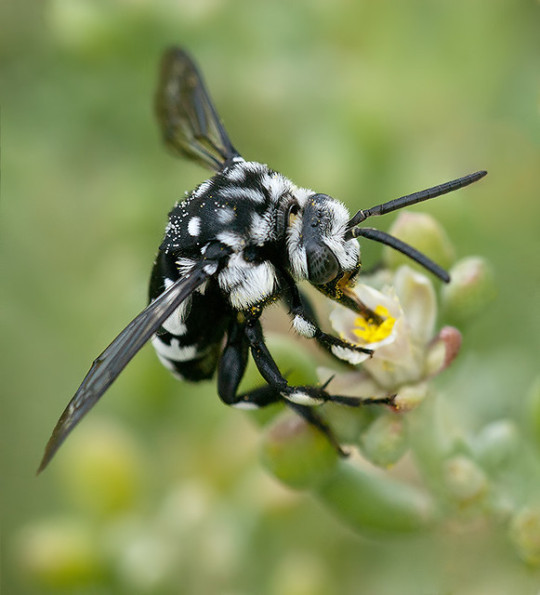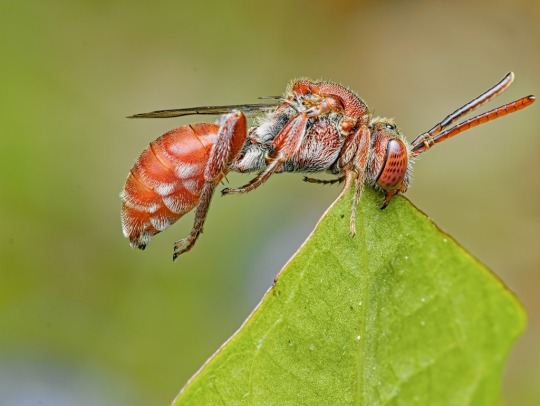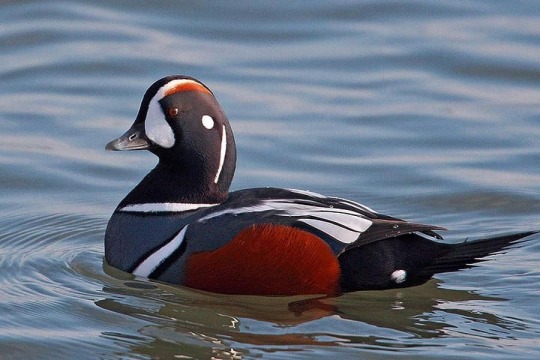#histrionicus
Explore tagged Tumblr posts
Note
Do you have more pictures of harlequin ducks? I love them
This really is one of my favorite ducks:
The first time I saw Harlequin Ducks was on the beach at Wellfleet Bay, Cape Cod, MA. It was 24 deg F, and the wind was blowing hard. It was hell, but it was worth it when I finally found the HDs in my spotting scope.

Harlequin Duck (Histrionicus histrionicus), male, family Anatidae, order Anseriformes, New Jersey, USA
photograph by MattSullivan

Harlequin Duck (Histrionicus histrionicus), male, far northern United States
photograph by Jacob W. Frank / NPS

Harlequin Duck (Histrionicus histrionicus), T - female, B - male, NJ, USA
photograph by Peggy Cadigan

Harlequin Duck (Histrionicus histrionicus), males, OR, USA
photograph by Keith Kohl, ODFW
#duck#histrionicus#anatidae#ocean#north america#anseriformes#waterfowl#bird#ornithology#animals#nature
301 notes
·
View notes
Text

Harlequin Duck
49 notes
·
View notes
Text

Histrionicus histrionicus (1929-1932) | Allan Brooks (canadiano, 1869-1946)
0 notes
Text

A young Harlequin duck, (Histrionicus histrionicus), practices its feeding skills in the rushing waters of the Yellowstone River, Yellowstone National Park, Wyoming
(c) riverwindphotography, September 2023
269 notes
·
View notes
Text

Harlequin Duck (Histrionicus histrionicus)
Family: Duck Family (Anatidae)
IUCN Conservation Status: Least Concern
This small, rotund species of duck is most often seen in oceans off the coast of eastern Eurasia and western North America (with smaller populations off North America's eastern coast,) but migrates inland during around April to breed and nest near cold, fast-moving rivers and streams. Pockets of air trapped in a Harlequin Duck's feathers provide insulation and make it extremely buoyant even by the standards of other ducks, allowing it to safely float on the surface of choppy water and quickly re-surface after diving for prey (feeding mostly on crustaceans and molluscs while at sea but taking aquatic insects as prey when in freshwater.) Like many waterfowl adults of this species are loosely monogamous and re-unite every year to mate, although its not uncommon for one or both partners to also seek out other mates after pairing and even "divorce" their partner upon finding a preferred mate. Female Harlequin Ducks (which are a dusty brown colour) build their nests along the banks of the fast-flowing streams they favour and typically incubate their eggs and raise their chicks alone, but on occasion the more flashily coloured males may also contribute to the early care of their young.
----------------------------------------
Image Source: Here
#Harlequin Duck#harlequin duck#duck#ducks#zoology#biology#ornithology#marine biology#bird#birds#seabird#seabirds#waterfowl#animal#animals#wildlife
25 notes
·
View notes
Video
Harlequin Ducks (Histrionicus histrionicus) by Adam Swaine Via Flickr: Fairly small, boldly patterned diving duck that lives a seemingly dangerous life near fast-moving water and jagged rocks. Male is striking and unmistakable. Female is dark brown with small white patches on face; compare with female scoters but note smaller size and smaller bill of Harlequin. In summer, almost invariably seen in pairs on rocky streams where they breed. Gathers in small flocks on rocky coastlines in winter. Feeds on insects, fish, and aquatic invertebrates
#ducks#duck#West Sussex#wetlands#RSPB#arundel#wwt#wildlife#wild#WINTER#beautiful#england#english#english birds#british birds#british#britain#animals#walks#waterside#water#water birds#nature lovers#nature#natures finest#nature watcher#nature reserve#seasons#South East#uk
9 notes
·
View notes
Text
#pls rebagel#I’m thinking I’ll take the top three from each poll and do a final deathmatch#apologies if your favorites never made the list
189 notes
·
View notes
Photo


Harlequin Duck Histrionicus histrionicus
In winter, Harlequin ducks are found almost exclusively on rocky coastal shorelines. In this habitat they feed on crabs, barnacles, mussels, and snails.
photographs by Bob Wick/BLM & National Park Service
via: USFWS Waterfowl Working Group
#duck#waterfowl#migrant#bird#birds#ornithology#birdwatching#animals#nature#north america#aquatic#ocean
79 notes
·
View notes
Photo

Hen and Drake Harlequin ducks (Histrionicus histrionicus)
5/13/23
66 notes
·
View notes
Text
Animal spotlight!
Starting off with a personal favourite, we have the cloak-and-dagger bees, genus Thyreus! I'd love to say they're my favourites because they're exceptionally interesting but it is mainly because I find them very cute and beautiful :3 I am not immune. Thyreus histrionicus (David Marquina Reyes) and Thyreus himalayensis (marcelfinlay on iNaturalist)


They are kleptoparasites, meaning that they lay their eggs in other bees' nests so their larvae can feed on pollen collected for the host's larvae, much like a cuckoo (lending various kleptoparasitic bees the title of cuckoo bees). They also often kill and eat their new nestmates.
One of my favourite things about them is their roosting behaviour. They sleep attached to twigs or dead plants by the mandibles! This isn't exclusive to the genus, many solitary bees sleep this way, particularly males. Here, two histrionic cloak-and-dagger bees can be seen roosting alongside some white-banded digger bees, Amegilla quadrifasciata (a species that they parasitise!). Image by David Marquina Reyes

And here is an articulated nomad bee (Nomada articulata, another cuckoo bee) doing the same! Image by jerremie on iNaturalist

4 notes
·
View notes
Text
Histrionicus histrionicus

By Peter Massas, CC BY-SA 2.0
PLEASE SUPPORT US ON PATREON. EACH and EVERY DONATION helps to keep this blog running! Any amount, even ONE DOLLAR is APPRECIATED! IF YOU ENJOY THIS CONTENT, please CONSIDER DONATING!
Name: Histrionicus histrionicus
Status: Extant
First Described: 1828
Described By: Lesson
Classification: Dinosauria, Saurischia, Eusaurischia, Theropoda, Neotheropoda, Averostra, Tetanurae, Orionides, Avetheropoda, Coelurosauria, Tyrannoraptora, Maniraptoriformes, Maniraptora, Pennaraptora, Paraves, Eumaniraptora, Averaptora, Avialae, Euavialae, Avebrevicauda, Pygostylia, Ornithothoraces, Euornithes, Ornithuromorpha, Ornithurae, Neornithes, Neognathae, Galloanserae, Anseriformes, Anseres, Anatoidea, Anatidae, Anatinae, Mergini
Today we’re going a little out of order because of time crunches on my end - so here’s the Harlequin Duck, Histrionicus histrionicus! The Harlequin Duck is a Sea Duck, living primarily in locations near streams with high levels of surf and turbulance, usually along and near northern coasts. They are most found in Russia and the Pacific Northwest, though there are endangered populations (due to oil spills) in Eastern North America, Greenland, and Iceland. Overall, the bird is not considered threatened with extinction. It is red on its wings, and it has black white and grey stripes over its body in the males; while the females are mostly brownish. They usually weigh up to 600 grams, and feed by swimming under water and diving, eating molluscs and arthropods. They have densely packed feathers for insulation, and interestingly enough there all fossils of this species from the Miocene, making it a very old bird indeed (about 11 million years old).
Buy the author a coffee: http://ko-fi.com/kulindadromeus
Source:
https://en.wikipedia.org/wiki/Harlequin_duck
#histrionicus#histrionicus histrionicus#harlequin duck#bird#dinosaur#duck#palaeoblr#birblr#paleontology#prehistory#prehistoric life#dinosaurs#biology#a dinosaur a day#a-dinosaur-a-day#dinosaur of the day#dinosaur-of-the-day#science#nature#factfile#Dìneasar#דינוזאור#डायनासोर#ديناصور#ডাইনোসর#risaeðla#ڈایناسور#deinosor#恐龍#恐龙
39 notes
·
View notes
Text

Harlequin Duck (Histrionicus histrionicus), male, family Anatidae, order Anseriformes, off the coast of NJ, USA
Photograph via: Hidden New Jersey
392 notes
·
View notes
Photo

Harlequin Duck
97 notes
·
View notes
Photo

Moretta Arlecchino 🦆🎨#HistrionicusHistrionicus #painting #harlequinduck #anatidae #duck #moretta #Histrionicus #art https://www.instagram.com/p/B-KLKM1CBY2/?igshid=NGJjMDIxMWI=
0 notes
Text

A female Harlequin duck, (Histrionicus histrionicus), relaxes alongside the Yellowstone River, Yellowstone National Park, Wyoming
(c) riverwindphotography, September 2023
233 notes
·
View notes


